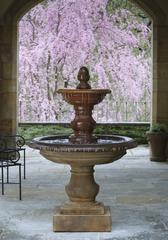The first inscription of the fountain discusses a ruined fountain being “restored to its noble antiquity”. This is the first time documentation was made about the restoration of a fountain, and it must have been an important fountain for it to have even been mentioned. The architect Bramante was the head architect under Pope Alexander VI, who commissioned the restoration of the Trastevere fountain, and judging by the inscription, this fountain was older than the city of Rome itself.
 There are many myths that surround the fountain, that say a lot but really tell us nothing. Every guide from the 17th century onward has copied older stories and exaggerations, all relating the fountain to being built by Pope Hadrian I (772-795). Interestingly enough, there is no account of this fountain recorded by Hadrian, so this is probably a story someone made up in the 17th century.
There are many myths that surround the fountain, that say a lot but really tell us nothing. Every guide from the 17th century onward has copied older stories and exaggerations, all relating the fountain to being built by Pope Hadrian I (772-795). Interestingly enough, there is no account of this fountain recorded by Hadrian, so this is probably a story someone made up in the 17th century.
Cardinal Lopez had an inscription added to the fountain, commemoration the restoration he had done. The inscription does not exist to this day, but it went along these lines, "If the gentle murmur of the water that falls into shivering pools lulls you to pleasant sleep; if you drink its clear drops and it washes you sparkling clean, give thanks to the Wolf who made the fountain. Now, Romulus, look at this fountain and the part he played in it and tell me the truth: Is not this Male Wolf as much a father to you as the Female Wolf was a mother to Remus?" Clearly this was a play on his family name, with lopez meaning wolf.
Only a few years after the previous work, in 1509, it would be embellished again by Pope Julius II, claiming it had lost it shape.
The Aqua Alsietina, the aqueduct that had previously fed the fountain, was damaged beyond repair in 1590-91. The water source was then taken from the Aqua Felice by Pope Sixtus V, who brought this water source to Rome three years earlier. This came from a brand new conduit, currently known as the Ponte Rotto Bridge that stands close yo the Palatine Bridge.
